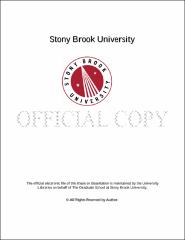| dc.identifier.uri | http://hdl.handle.net/11401/77132 | |
| dc.description.sponsorship | This work is sponsored by the Stony Brook University Graduate School in compliance with the requirements for completion of degree. | en_US |
| dc.format | Monograph | |
| dc.format.medium | Electronic Resource | en_US |
| dc.language.iso | en_US | |
| dc.publisher | The Graduate School, Stony Brook University: Stony Brook, NY. | |
| dc.type | Dissertation | |
| dcterms.abstract | Limb reduction and vestigialization have occurred multiple times in the evolutionary history of Tetrapoda, most often related to a change in primary mode of locomotion. However, little is known about the functional shifts of reduced limbs or the morphological signals of complete vestigialization. The forelimbs of nonavian theropod dinosaurs, freed from the requirements of terrestrial locomotion, diversified into a wide variety of morphologies including extreme reduction relative to body size. Whether these limbs were functional or merely vestigial is a matter of contention. The primary objective of this dissertation was to provide new insights on the evolution and function of reduced forelimbs in nonavian theropod dinosaurs through analysis of the osteology, myology, and allometric trends of the forelimb. In the first part of this analysis, the osteology of the pectoral girdle and forelimb of the early theropod <italic>Tawa hallae</italic> and that of the abelisaurid <italic>Majungasaurus crenatissimus</italic> were described to provide a detailed understanding of the extremes in morphology exhibited by the plesiomorphic and highly reduced conditions. The osteological features of the forelimbs of these taxa were used in combination with integrative phylogenetic and comparative techniques to reconstruct the complete musculature of the forelimb and pectoral girdle of <italic>Tawa</italic> and <italic>Majungasaurus</italic>. The results of these studies established the plesiomorphic arrangement of the musculature in Theropoda and demonstrated the myological consequences of extreme forelimb reduction in one clade. Next, shifts in the forelimb musculature were traced along the lineage to another clade exhibiting forelimb reduction, Tyrannosauroidea. The forelimb musculature of <italic>Tyrannosaurus rex</italic> was reconstructed and major changes in the musculature were identified, allowing tests of established functional hypotheses through biomechanical analyses. The results reveal that the forelimb musculature of derived tyrannosaurids was well developed despite the reduced size of the limb, featuring several unique adaptations likely related to prey acquisition and intraspecific interactions. The final study assessed allometric and evolutionary trends of the pectoral girdle and forelimb across Theropoda using phylogenetic comparative methods, evolutionary model testing, and ancestral state reconstruction. Results of this study show that there is no evidence of negative allometric scaling of the forelimb elements across the entire clade when phylogeny is taken into account, despite long-standing hypotheses that variations in forelimb length of nonavian theropods, whether reduction in tyrannosaurids or elongation in paraves, are directly dependent on overall body size. Instead, clades exhibiting forelimb reduction or elongation underwent active stabilizing selection toward their distinctive proportions. The results also indicate that the relative forelimb length of most theropods and the scapular length across the entire clade exhibit a high degree of conservatism due to strong stabilizing selection, suggesting that biomechanical, developmental, or functional constraints were important in influencing forelimb proportions in most members of this clade. Taken together, these studies indicate that the reduced forelimbs of nonavian theropods were not a result of the process of vestigilization and remained functional even at their small size, likely maintaining roles in prey acquisition, reproduction, or intraspecific display interactions. | |
| dcterms.available | 2017-09-20T16:52:03Z | |
| dcterms.contributor | Demes, Brigitte | en_US |
| dcterms.contributor | Krause, David W | en_US |
| dcterms.contributor | Gatesy, Stephen. | en_US |
| dcterms.contributor | Turner, Alan H | en_US |
| dcterms.creator | Burch, Sara | |
| dcterms.dateAccepted | 2017-09-20T16:52:03Z | |
| dcterms.dateSubmitted | 2017-09-20T16:52:03Z | |
| dcterms.description | Department of Anatomical Sciences. | en_US |
| dcterms.extent | 422 pg. | en_US |
| dcterms.format | Monograph | |
| dcterms.format | Application/PDF | en_US |
| dcterms.identifier | http://hdl.handle.net/11401/77132 | |
| dcterms.issued | 2015-08-01 | |
| dcterms.language | en_US | |
| dcterms.provenance | Made available in DSpace on 2017-09-20T16:52:03Z (GMT). No. of bitstreams: 1
Burch_grad.sunysb_0771E_11659.pdf: 31660413 bytes, checksum: 8ee0a47bb7d6469b1443b0ad1ee43dc0 (MD5)
Previous issue date: 2013 | en |
| dcterms.publisher | The Graduate School, Stony Brook University: Stony Brook, NY. | |
| dcterms.subject | Dinosauria, forelimb, functional morphology, myology, Theropoda, vestigiality | |
| dcterms.subject | Paleontology | |
| dcterms.title | Osteological, Myological, and Phylogenetic Trends of Forelimb Reduction in Nonavian Theropod Dinosaurs | |
| dcterms.type | Dissertation | |

